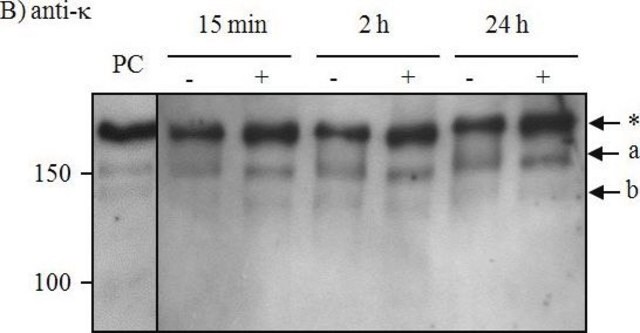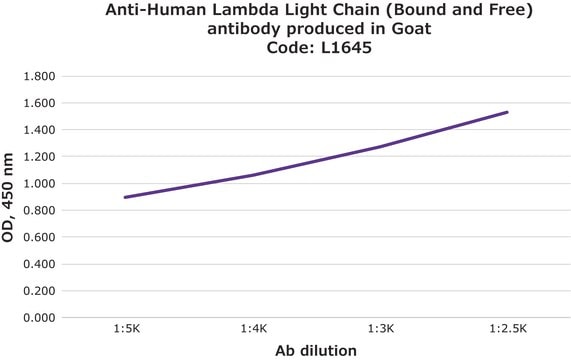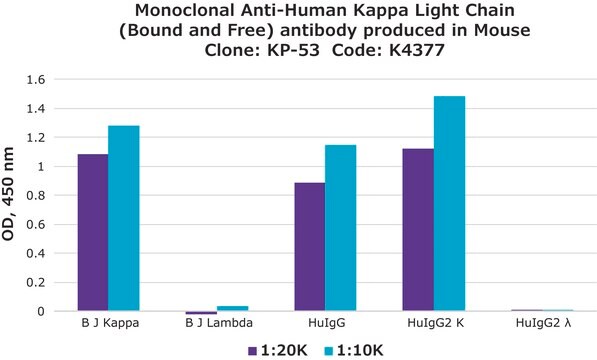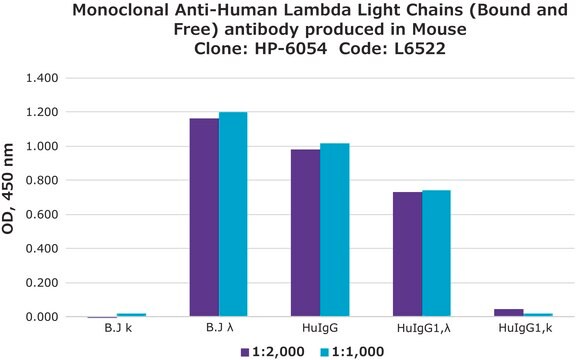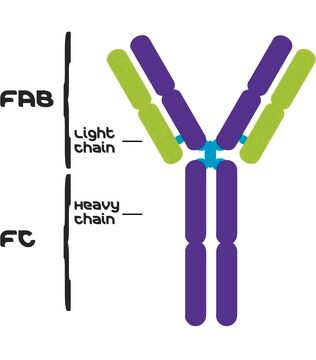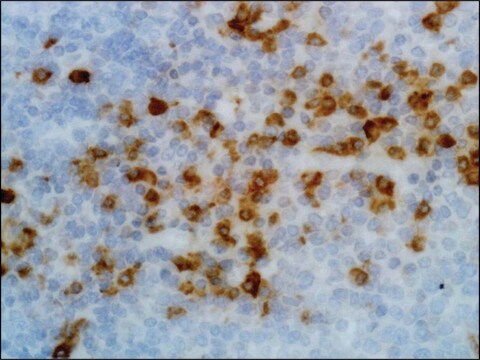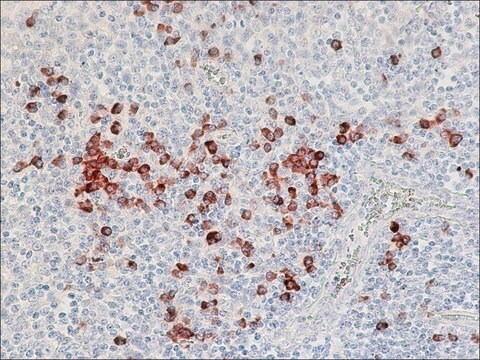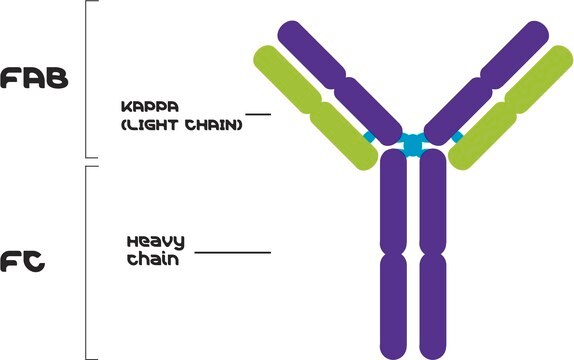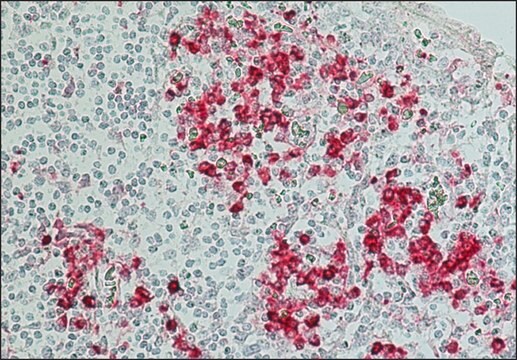Alle Fotos(1)
Wichtige Dokumente
K3502
Anti-Human Kappa Light Chain (Bound and Free) antibody produced in goat
affinity isolated antibody, lyophilized powder
Anmeldenzur Ansicht organisationsspezifischer und vertraglich vereinbarter Preise
Alle Fotos(1)
About This Item
Empfohlene Produkte
Biologische Quelle
goat
Qualitätsniveau
Konjugat
unconjugated
Antikörperform
affinity isolated antibody
Antikörper-Produkttyp
secondary antibodies
Klon
polyclonal
Form
lyophilized powder
Methode(n)
quantitative precipitin assay: suitable
Lagertemp.
2-8°C
Posttranslationale Modifikation Target
unmodified
Angaben zum Gen
human ... IGK@(50802)
Suchen Sie nach ähnlichen Produkten? Aufrufen Leitfaden zum Produktvergleich
Allgemeine Beschreibung
Anti-Human κ Light Chain (bound and free) antibody is obtained from goat antiserum. Immunospecific purification removes all goat serum proteins and immunoglobulins that do not bind to the κ light chain (bound and free). The antibody preparation is specific for κ light chains when tested against bound and free light chains. The product shows no reaction with bound or free λ light chains.
Immunogen
Purified human normal and myeloma κ light chain
Anwendung
Anti-Human κ Light Chain (Bound and Free)-FITC antibody was used for as secondary antibody in ELISA at a working antibody dilution of 1:200 using maize seed extracts. For ELISA using NSO/1 myeloma cells, HEK293 cells and mouse plasma, antibody concentration of 1-2 μg/ml was used. The antibody was also used to coat the electrode surface in the preparation of antiatrazine immunosensor.
Anti-Human Kappa Light Chain (Bound and Free) antibody produced in goat has been used in western blotting.
Physikalische Form
Lyophilized from 0.01 M sodium phosphate, 0.015 M sodium chloride, pH 7.2
Rekonstituierung
Reconstitute with 0.135 M sodium chloride.
Haftungsausschluss
Unless otherwise stated in our catalog or other company documentation accompanying the product(s), our products are intended for research use only and are not to be used for any other purpose, which includes but is not limited to, unauthorized commercial uses, in vitro diagnostic uses, ex vivo or in vivo therapeutic uses or any type of consumption or application to humans or animals.
Sie haben nicht das passende Produkt gefunden?
Probieren Sie unser Produkt-Auswahlhilfe. aus.
Hier finden Sie alle aktuellen Versionen:
Besitzen Sie dieses Produkt bereits?
In der Dokumentenbibliothek finden Sie die Dokumentation zu den Produkten, die Sie kürzlich erworben haben.
Kunden haben sich ebenfalls angesehen
Characterization of immunological interactions at an immunoelectrode by scanning electron microscopy
Ambrosi A et al
Electroanalysis, 19, 244-252 (2007)
Yvonne J Rosenberg et al.
PloS one, 11(3), e0152760-e0152760 (2016-04-01)
Intravascular delivery of broadly neutralizing antibodies (bnAbs) has shown promise for prevention and treatment of HIV infection. However, multiple IV administrations in geographic locations with poor accessibility to medical care have practical limitations. We have assessed the efficacy of plant-derived
Yvonne Rosenberg et al.
PloS one, 8(3), e58724-e58724 (2013-03-28)
Passive immunotherapy using anti-HIV broadly neutralizing monoclonal antibodies (mAbs) has shown promise as an HIV treatment, reducing mother-to-child-transmission (MTCT) of simian/human immunodeficiency virus (SHIV) in non-human primates and decreasing viral rebound in patients who ceased receiving anti-viral drugs. In addition
Ruben J Boado et al.
Biotechnology and bioengineering, 96(2), 381-391 (2006-08-29)
A murine monoclonal antibody (MAb) to the human insulin receptor (HIR) has been engineered for use as a brain drug delivery system for transport across the human blood-brain barrier (BBB). The HIRMAb was humanized by complementarity determining region (CDR) grafting
S M Chamow et al.
Journal of immunology (Baltimore, Md. : 1950), 153(9), 4268-4280 (1994-11-01)
HIV infection depletes the immune system of the coordinating functions of CD4+ T cells and APCs, whereas the population of CD8+ CTLs remains largely intact: functional but undirected. We have developed a humanized bispecific immunoadhesin-antibody (BIA) that redirects these remaining
Unser Team von Wissenschaftlern verfügt über Erfahrung in allen Forschungsbereichen einschließlich Life Science, Materialwissenschaften, chemischer Synthese, Chromatographie, Analytik und vielen mehr..
Setzen Sie sich mit dem technischen Dienst in Verbindung.